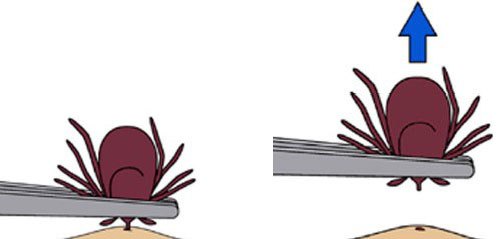How To Avoid Ticks And What To Do If A Tick Bites You Image courtesy of Violentz
The bad news (for humans): It’s shaping up to be a great year for disease-bearing ticks. The good news: We can tell you how to defend your body and your yard from these pests.
Epidemiologists and other experts are warning that factors like climate change are boosting tick populations in U.S.: Warmer temperatures allow ticks to hit the road and spread farther north than they usually would, as well as to higher altitudes.
“As the climate warms, the ticks become active earlier and earlier in the season,” Richard Ostfeld of the Cary Institute of Ecosystem Studies at Yale explained to a university publication.
According to the Centers for Disease Control and Prevention, tickborne diseases are on the rise: Every year, more than 30,000 cases of Lyme disease are reported to the agency, but studies suggest that the number of people diagnosed is closer to 300,000.
You should be especially wary if you live in one of these 14 states, which home to 95% of all Lyme disease cases: Connecticut, Delaware, Maine, Maryland, Massachusetts, Minnesota, New Hampshire, New Jersey, New York, Pennsylvania, Rhode Island, Vermont, Virginia, and Wisconsin.
Again, the range of tick that transmits Lyme disease is expanding, so everyone should be prepared.
And Lyme disease isn’t the only worry, as the CDC notes there has been an increase in other less known, but serious diseases, including Rocky Mountain spotted fever, anaplasmosis, ehrlichiosis, Powassan virus, and babesiosis.
How To Prevent Tick Bites
Destroy their homes: Ticks love hiding out in tall grass and shade, so keep your lawn mowed and tidy up any leaves and debris, suggest our colleagues at Consumer Reports. You can also spray your lawn with insecticide approved for residential spraying. Consumer Reports has some more tips on that process here.
Avoid them in the wild: Steer clear of areas with high grass and leaf litter when you’re out hiking, and keep to the center of the trail to prevent ticks from latching on, recommends the CDC.
Use insect repellant and dress accordingly: Even if it’s a hot summer hike, wearing pants, long-sleeved shirts, and socks tucked into closed shoes will discourage ticks from getting to your skin. Clothing treated with permethrin can also help ward off pests.
And don’t forget to spray yourself down with insect repellant — Consumer Reports suggests looking for products containing 15-30% deet. Anything over that isn’t effective.
Do a tick check when you get home: Strip down after your hike and find a mirror — you’ll want to get up close and personal to inspect yourself (or your kids) for ticks. Shower or bathe as soon as possible (preferably within 2 hours) to wash off any you may have missed.
Kill them with your dryer: The CDC recommends washing our clothing right away with hot water to kill any hangers-on. If you don’t have access to hot water, a dryer will do: Tumble dry clothes in a dryer on high heat for 10 minutes (damp clothing will take longer).
Treat your pets: Tick collars, sprays, shampoos, and a monthly “top spot” dose of medication can help protect your pooch from ticks, says the CDC.
What To Do If A Tick Bites You
Spot a tick? It’s important to remove it right away.
1. Get a pair of fine-tipped tweezers and grasp the tick as close to the skin’s surface as possible.
2. With steady, even pressure, pull upward. Avoid twisting or jerking the tick, as it could cause its mouth-parts to dislodge and stick in your skin. If that does happen, remove those bits with the tweezers if you can. But if you can’t get them out, the CDC says to just leave it alone and let the skin heal.
3. Once you’ve removed the tick, clean the bite area and your hands thoroughly with rubbing alcohol, an iodine scrub, or soap and water.
4. Get rid of the body in a bath of alcohol, put it in a sealed bag or container, wrap it tightly in tape, or flush it down the toilet. Do not crush a tick with your fingers.
What you should definitely not do: Folk remedies like “suffocating” ticks with butter, petroleum jelly, or other thick, waxy substances won’t work. Using heat from a glowing match also will not work, and could encourage the tick to burrow deeper into your skin. Both of these methods waste time and give the tick a better chance of passing on its diseases.
If you develop a rash or fever within several weeks of removing a tick, it’s time for a trip to the doctor. Make sure to let your physician known when you were bit and where you most likely picked up the tick.
Want more consumer news? Visit our parent organization, Consumer Reports, for the latest on scams, recalls, and other consumer issues.




